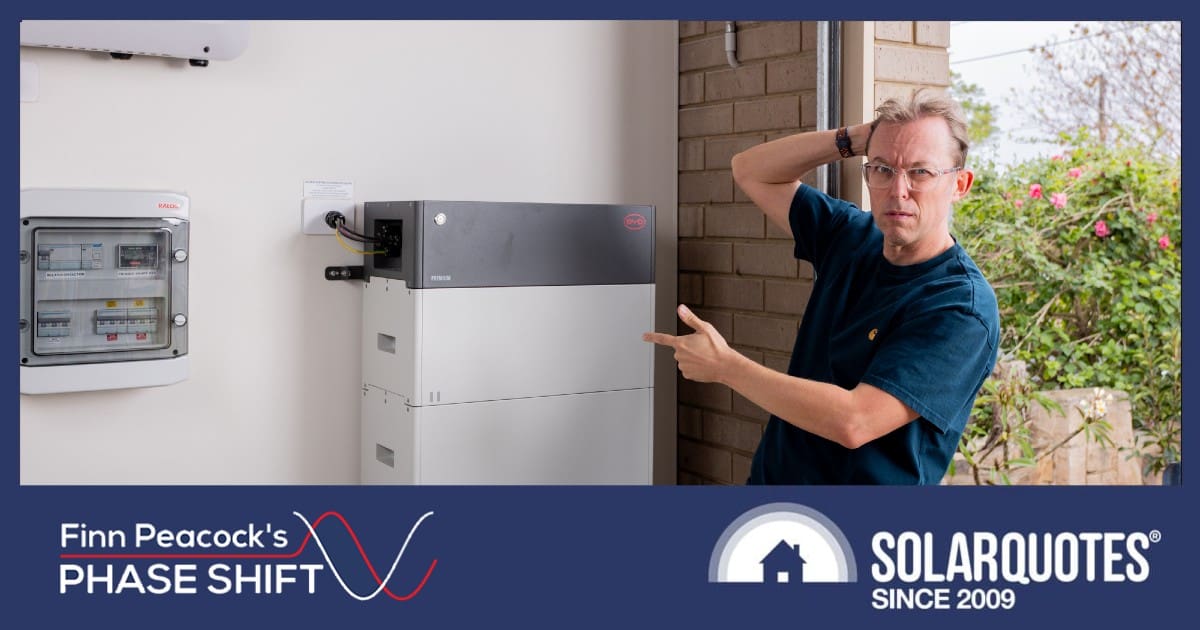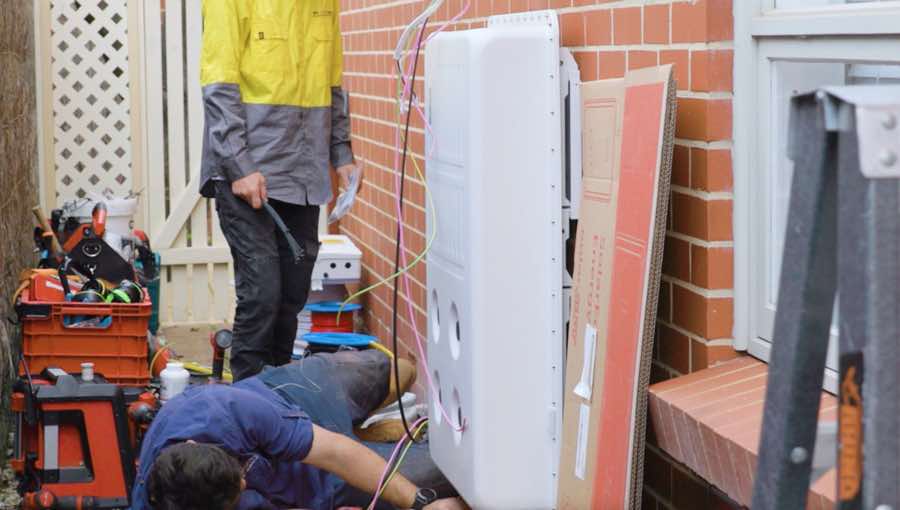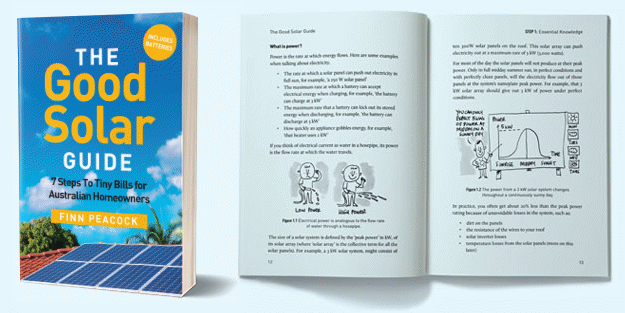 Labor’s back in power, and now the battery rebate is locked in.
Labor’s back in power, and now the battery rebate is locked in.
From July 1, Australians will be able to knock about $4,000 off a home battery. The goal? A million new batteries by 2030. Based on the number of quote requests we’ve seen at SolarQuotes, up 5x since election night, this is going to move the needle fast.
It’s the biggest shift in household energy since the rooftop solar boom. And if solar decimated the middle of the demand curve, batteries are about to take a bite out of the evening peak.
We’ve talked about the duck curve for years. Now it might finally get roasted.
But this isn’t just about bills and load shaping. Batteries are popular because they’re useful and desirable. They save money, keep the lights on during outages, and they look cool (as long as they are well-installed). Batteries are fast becoming the home tech people really want.
It’s a kind of materialism that doesn’t hurt the environment but helps it.
Another Nail In The Coffin For V2G
The rebate doesn’t just make batteries cheaper. It kills what’s left of the argument for Vehicle To Grid (V2G), which enables electric vehicle batteries to discharge to the grid.
Think about it: with modular systems like Sigenergy or BYD, you can add extra storage later at around $400 per kilowatt-hour after the rebate. No fiddling with EV charge levels, no family drama over unplugged cars, no $4,000 bidirectional charger.
Why bother using your car as a home battery when the real thing is this cheap and this easy?

Battery installs can be complicated, but the rebate will push the industry to streamline the process.
Streamlining Battery Installs
Battery installs are going to get faster too. Just like STCs helped drive down solar installation costs, this rebate will push the industry to streamline battery installs. Fewer cables, faster commissioning. Expect most brands to follow Sigenergy with easy-add stackable systems1.
This is what happens when government policy meets good tech: things scale.
A battery in the garage used to be a niche product for off-gridders and enthusiasts. Now it’s becoming standard kit. Because it’s useful. Because it’s affordable. Because, frankly, it’s cool.
We’ve entered the second phase of the home energy shift. Not just generation, but proper, household-level storage. And if this rollout mirrors the rooftop solar boom, the impact will be massive.
Labor may have won the election.
But the real winner is the battery.
For more on the impact of Labor’s Cheaper Home Batteries Program, take a look at our explainer on the scheme, our guide on what discount it offers for the best batteries available, and our federal battery rebate calculator.
Footnotes
- Tesla also does this but only in 13.5 kWh megachunks when the DC expansion pack is released ↩

 RSS - Posts
RSS - Posts



Thanks Finn. I had been thinking that a battery would not be much of a benefit to me as my bills are significantly in credit. But your article made me do a quick calculation.
I have a bit over 9kw of solar with a 7kw 3 phase inverter on a well sited roof. I am not a big user of electricity. While good for the environment and network demand in peak times a battery hadn’t seemed to make good financial sense. However, your article prompted me to do the calcs and with the new grant, the situation has changed. And particularly once I start renting out the flat (not separately metered) on my property so use goes up, a 10kwh battery really becomes attractive. It would pay for itself in 5 years or probably less, particularly if the NSW government also keeps its subsidy scheme.
This really is a dynamic shift for the network, consumers and the environment. It will also significantly help our chances of holding the next COP meeting, which should bring benefits to our solar industries.
It’s a great idea to future proof too Patrick.
I can see retailers / regulators allowing more changes in coming years, even further declining FITs, increasing sun tax, increasing supply and network charges on bills . . . so a battery to help get the most protection from increasing changes, shifting goal posts, is very wise.
One can always shift to a wholesale type supplier too, if retailers get too much influence over other increases.
Retailers / shareholders are not going to like this shift to possible total self reliance by this many consumers, and I can’t see them being able to squeeze out the probable losses by shifting that to people who can’t get solar and batteries for whatever reason (financial, renters, etc).
Just be aware that if you rent out your flat, any capital gain on your property becomes taxable on a pro-rata basis–based on the time your flat is rented out, and the proportion of the property’s total floor area covered by the flat.
I was planning to build my next house as two flats, and rent one out–but when I did the arithmetic it’s not worth it. I shall claim the old age pension instead. Really dumb policy!
Nicholas Yes, thanks for mentioning it. I was aware that part of the capital gain would be taxed. But that really doesn’t worry me.
Firstly I it will only be rented out for part of the time it will be occupied as I have lived in it first before completing the house. And possibly I might give up renting it as I age more and can’t be bothered with the admin – if I make it that far! I’m heading for 70 so who knows when I will shuffle off?
Secondly, like my dear old Mum, “the only way I am going out of this house is in a box!” Mind you, she had to go into a nursing home and lived there for quite some time. Meantime her house was rented and it appreciated significantly.
Thirdly paying the CGT won’t be my problem, but my kids’ who live a long way away. And they will do very nicely out of it anyway.
Patrick,
remember you can possibly write off part of the cost of the battery against your rental income. I guess this would be portioned on the expected usage, but you could argue 50:50 if the loads were similar, so write off over 10 years? That makes a cheap battery!
Thanks Doug – I hadn’t thought about that. While you are probably right about offsetting some of the cost, the ATO advises solar systems are depreciating assets (20 year life) though I am not sure it would be covered in the instant asset write off provisions. Am I conducting a business? That is the key question. At minimum I should be able to claim them as part of depreciation on the property.
Someone more knowledgeable than me may be able to advise.
The EV you would be using as a house battery is going to be obsolete. And if you or your superannuation fund invested in lithium mining – bad luck. The new sodium-ion technology will make charging at home as sensible as having a petrol bowser there.
Of course it may take longer than a speed rail project between Sydney and Melbourne before gas stations will have chargers capable of delivering 1 Megawatt to charge EV in 5 min to run 500-800 km. I do not expect current EV technology to disappear here for at least a decade. With so much solar energy to be harvested at home, Australia may become a dumping ground for lithium-ion EVs as it was for petrol cars.
Finn, I feel you may be wrong about V2G. Personally, I already have a 12Kw battery, but my next vehicle will be capable of V2G. I will use a (yet to be released, but predicted $1500 cost) AC bi-directional charger. Yet to see the details of the AC connection, but I guess it will be export limited to the car on-board inverter (ie usually abt 3.5Kw).
Where I can see this being used is that the vehicle will supply the grid (after personal use) between 5pm & 8pm, when my normal retailer would request grid feed & pay some premium (eg Peak power cost to me 42c/kwh, Export would be say $1.50 kwh: any less it is not worth exporting!) The vehicle would be recharged later in the evening to replace the energy used + more if required, or wait & recharge off PV next day. At 3.5Kw, there could be an export of abt 10Kw available.
I think the Energy retailers will need to accommodate energy export, paying clients a reasonable recompense. Even 1:1000 clients connecting is big Virtual Generator.
Have to agree that V2G should not be regarded as dead.
I am just looking at a solar system for a new house. Was originally looking at a battery of 10-15kWh but with the new government rebates will be installing around 25kWh. Even so, this is dwarfed by the 75kWh capacity of my Tesla’s battery.
With Amber I can export energy in 5-8pm peak times at high peak wholesale rates, so the more battery capacity I have the better. And it’s also good for the grid by reducing peak generation requirements.
I was impressed by SigEnergy setup. If I was building again, I would consider them. They also have a bi-directional DC charger (25Kw for 3 phase) that has
been tested by Essential Energy development lab in Port Macquarie. I heard their talk at the recent Energy Conf in Sydney. I think they had a T%^** working with the SigEnergy too (even tho T… says it does not have the capability!). There were only a couple of vehicles they had issues with. Their only certified setup was SigEnergy, & the Ford F150. The others are waiting for the manufacturers to approve V2G.
Hard agree with all of that.
I have said from the outset that this will be a very popular policy. As the household battery price per kWh comes down (before install and subsidy) batteries are going to become a no-brainer.
I hope the industry can cope with the initial surge and I hope there is a Plan B for when the ‘target’ is met.
We have a BYD HVM battery stack. Not sure how you arrived at around $400 per kWh to add modules.
If you can do it at that rate, please come and add three modules to our 5 module stack.
Lowest retail price I can find with a full 30% discount applied is closer to $500 with out installation.
If you’re buying a electric car anyway why not have it v2g capable surely EVERYTHING that supplies energy to the grid say between 3 and 9 is a bonus to all concerned !!
Great news all round. I can only agree with your comments.
Thank goodness we’re not going down the nuclear path. THAT would have been an expensive nightmare.
And yes- I’m damned if I want to use my EV to prop up the grid. V2L might be nice occasionally but V2G- NO WAY!
David, apparently, using the EV battery for V2G is much easier on the battery than a drive down the block! V2G will be economically worthwhile, but might not suit your circumstances, for instance a Doctor on call that needs the EV charged & ready. For the average householder, losing a bit of charge that is replenished before you need the vehicle is a no-brainer I feel (if you make money on the transaction).
Having the ability to call on EV batteries at times of crisis will be the real game changer. At the recent conference, they said if the projected EV numbers in 2035 were plugged & available 10% of vehicles, 10% of the time, there would be a virtual grid twice the size of current battery + Hydro power, including Snowy 2! That is the game changer!
My next vehicle will be V2G, & I will use the bi-directional capabilities. I already have a 12Kw battery.
That’s great $4,000.00 grant what does a good Home Solar Battery cost for a 8 solar Panel grid on a 3 bedroom house? please [email protected]
Most of us have an opinion on V2G. What eventuates in reality was probably going to depend on evening peak FiT. Payback for EV range sacrifice must suffice, or go cook on a candle. (1 kWh = 6 km = $1.08 in petrol, so 50c FiT = few takers?)
But now, a domestically distributed national battery with $2.3B/372 = 6.18 GWh of capacity, at full subsidy uptake, is two nuke reactors for three evening peak hours? OK, not all will feed in, self consuming instead, at grid-peak (top price) – *most certainly* if price exceeds FiT, for heavens sake! (Who’ll have battery to do both?)
But self consumption, especially during peak grid load, is *fully equal* to feed-in, as it *is* grid-unloading supply. That’s the not-quite-secret sweet spot for symbiotic consumer and grid benefit.
If $2.3B replaces 2 nukes for 3 hrs, then $64.4B would replace all $600B of 7 reactors for 24 hrs, for around 1/10 of the cost? Spend a bit more on distributed solar & wind for top-up, and nuke is not too bright a notion.
I just don’t see the value of depreciating an EV battery (and thus the overall vehicle) faster than they already devalue.
An EV that is worth having hooked up as V2G is generally going to need a larger battery, the EV might be in the $70k – $80k range.
A home battery where most can get by fine with 10kwh – 20kwh usable is plenty to power a the average home for a night, and with blackout protection on essential needs for some days with a hybrid system feeding it daily.
The other thing I wonder, if you do go the EV V2G way, can blackout protection be set up easily, just a matter of a suitable gateway ?
I read new articles of people in the aftermath of Alfred in SE Qld getting by for 3 – 4 days running essentials off their EVs.
Battery tech will certainly change all this in the near future.
In a decade what we have now will probably be like comparing stone age rock wheels with modern alloy rims and rubber.
Hi Les,
Search our blog for HOEM… that’s a great way to use V2L backup in the house.
Not sure this is the right place for this comment/ discussion. But here goes.
As a two person household with an 18 month old 6.6kW solar system, Sungrow inverter and Longi 440w monocrystaline panels, and a total YEARLY electricity bill of $630, with TOU billing, there is no applicable battery that is viable in terms of cost yet for such small usage. Is there?
Hi David,
The return on investment when your bill is already pretty modest would be a long term thing.
However you might want the security of blackout backup? Many don’t include the cost of a freezer full of food or the time spent dealing with it when they’re doing the beancounting for financials.
If you join up with a retailer like Amber you might be able to make some money back but as always the mileage may vary depending where you are and the seasonal variations which drive volatility in spot market prices.
Thanks for replying Anthony.
As far as backup, we have a reliable supply from Ausgrid.
The future plans for a used EV are a few years away, something like a BMW i3 for city/ suburban runaround use mostly 4 time a week, on overnight charging. So that could be on a slow mains charger or type 2.
V2H would be great.
In two years time one thing is certain, things will be different as fas as V2H. Maybe gone altogether?
I am wondering if there are many households that use as little electricity as we do? I suspect more than people realise.
I would be keen to instal a small battery, but it seems it is the same as solar, the installation is the main cost, whether it is for a 5kW or an 11kW battery.
Hi David,
For V2H you might be interested in this system. It’s quite basic but also far cheaper than full V2G.
Well it will certainly accelerate how we use, store and pay for energy. A big proportion of the capital cost, risk (financial and physical), opportunity costs and ownership costs still sits with the homeowner. Does it add to or detract from home resale value? For me if a hefty government subsidy was involved then it immediately detracts from future resale value – there a high chance dodgy brothers Pty Ltd sold and did the install so as a prospective buyer my assessment would be the battery and all associated kit needs to be removed and scrapped and start again
I have to disagree. Solar has added something to house value, & batteries will be the same. Any purchaser should do their homework on what is installed, & hopefully get the installation documentation on handover.
What is good with any Solar/Battery install is the basic wiring should be done, so if it is a crap install, the new install replacement should be less.
So, $5K>15K cost on a house average price of $800K is a piddle in a bucket anyway!
What is needed though is a checklist for potential home buyers to check for installs: Such as safety barriers, quality of install, age of install, if it is actually working, etc etc. (Perhaps a new page for SolarQuotes?)
Thanks Doug,
Great idea for a post. I needed another job on the list!
A check list is a great suggestion and it should be in the contract of sale so the risks are known and managed a bit like an asbestos register.
Unknown or Poor Installation Quality:
• dodgy or unverified installations can be a red flag.
• Buyers may fear hidden roof damage, poor wiring, or eventual system failure.
Unbranded or Obsolete Tech:
• Unknown brands or out-of-warranty systems can seem like future disposal liabilities.
• If a battery is degraded or not working properly, the cost of removal or replacement becomes a factor.
Incentive-Driven Boom = Quality Risks:
• Large government incentives (as seen in SA, VIC, QLD) have led to a proliferation of low-cost, low-quality systems.
• Some buyers are aware of this and now ask who installed the system and when, or request an independent assessment.
Compliance & Ownership Ambiguity:
• In some cases, systems are leased or under finance, not owned outright, which complicates sales.
With this new boom in batteries, and the lower reliance on grid-sourced electricity yet still needing to be grid connected for those blue moon days, what’s the bet our daily connection fee, (my retailer Red Energy calls it a Service to Property Charge) will just steadily increase to cover their lower profits.
Mine’s currently 85c.
“Oh, you have a battery? Your daily charge is $2.”
yep that’s what will happen and then we are more incentivised to drop grid altogether;
Government Incentives for Batteries make it more attractive for households to install batteries and reduce reliance on the grid.
Retailer Response – Increased Daily Supply Charges: As more people use less grid energy, network and infrastructure costs are spread over fewer kWh, leading retailers to recover those costs via higher fixed daily charges.
Resulting Feedback Loop:
Higher daily charges make partial grid use less economical.
More users then consider going fully off-grid, especially those with high solar generation and battery capacity.
Further grid defection leads to even higher charges for remaining users.
On the other side virtual power plants, frequency control markets could make staying grid-connected beneficial.
Basically perverse unintended consequences flow out of government interventions in markets as always
Hi Peter,
What you’re talking about is what the industry calls the death spiral, something we can’t allow to happen.
Where it’s gone astray is the neoliberal government intervention in what should be viewed as an essential service. The results of privatisation (overwhelmingly LNP enacted) are higher costs to consumers and profits delivered to offshore tax havens & speculators. The ACCC has come out to say these asset sales/leases aren’t in our interest.
The NEM is broken and needs to be redesigned into being a proper public good.
Grid defection is not always a problem for providers. In WA, remote consumers have been assisted with solar and batteries, to avoid costly transmission upgrades, and minimise the effects of outages. If the most remote go off-grid, everyone wins.
I’ve never been on-grid (in 60 years), and connection would be a waste of half a million dollars, plus maintenance.
Losing a few low-consumption users here and there might save the network money, reducing your costs or increasing profits.
Fear of mass defections might improve peak FiT, rewarding small-scale optimal ToU producers – or a levy imposed if lines pass your property can make defection futile. But FiT cannot be derisory, or go cook on a candle.
My brother has not yet thrown the breaker to go off-grid, as he is still paid to remain on. His LTO batteries would be ideal for evening peak feed-in, if adequately rewarded.
The grid is most beneficial in long periods of heavy cloud and rain. It becomes a weather sharing mechanism.
Spot on with the V2G killer call – at least for single phase constrained homes.
I was planning a Sigenergy battery awkwardly installed in my carport – reserving a module for future V2G so that the EV could backup the house.
With the low (post rebate) marginal cost, I ultimately signed for a 48kWh Sigenergy battery installed away from my carport. At 48kWh the battery will easily back up the house. It’s also big enough to soak up solar while I’m at work and allow a weekly EV charge at anytime without drawing from the grid – no need for the solar following Wattpilot function.